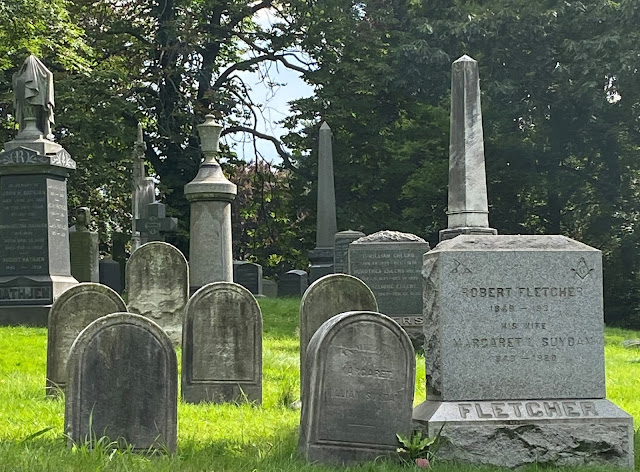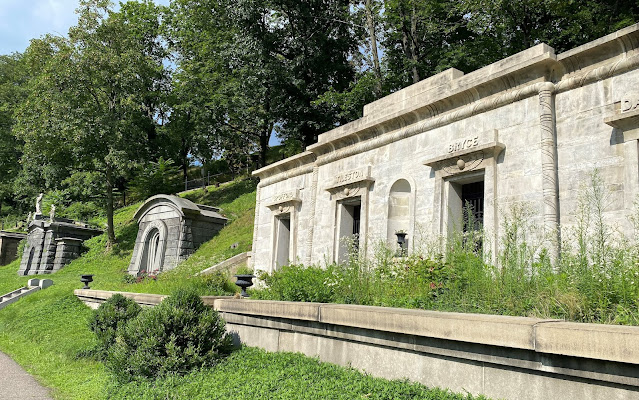July 22, 2021
Our son knows I like cemeteries, and I know he likes mushroom hunting, and we figured those two interests could converge. Old cemeteries are known not just for their history and architecture, but also for their old trees, which often harbor companion fungi. We planned an afternoon walk through Brooklyn's Green-Wood Cemetery to satisfy both of our interests.
Among the famous people buried here are musician Leonard Bernstain; artists Louis Comfort Tiffany, George Catlin, and Jean-Michel Basquiat; politician Boss Tweed; newspaperman Horace Greeley; the Rev. Henry Ward Beecher; NY Governor DeWitt Clinton, Nathaniel Currier and James Merritt Ives ("Currier and Ives"); Elias Howe (sewing machine inventor); Walter Hunt (safety pin inventor); Frank Morgan (the wizard in the movie The Wizard of Oz); Morse code inventor Samuel Morse; cabinet maker Duncan Phyfe, Teddy Roosevelt's first wife Alice, his mother Martha, his father Theodore, and his uncle Robert; toy store founder F. A. O. Schwarz; and Henry Steinway and his son William of Steinway piano fame. Fifty victims of the September 11 attacks are also buried here.
The main entrance to the cemetery is a gothic arch perfect for a cemetery. It was built in 1861-65.
Inside the passageway is a marble statue of two dead children, brother and sister. According to onsite information, "The work was one of many Victorian-era responses to the period's high rates of infant mortality by depicting death as sleep." A second version of this piece is in the Metropolitan Museum of Art.
 |
| The Babes in the Wood (c. 1850) by Thomas Crawford |
I'm sure I've noted in previous posts that I grew up visiting my dad's grave (he died when I was 4), and those mostly positive experiences created an abiding love in me for the peace and evocative power of cemeteries.
Green-Wood's vast expanse and solitude definitely had that effect on me.
Here are the graves of the Tiffany family (of Tiffany stained glass fame). They are surpisingly plain.
Unfortunately, while my experience here was wonderful, the mushroom hunting was a bit mediocre for my son, but here is one of his only finds:
I was pretty sure some British knight was buried in this elaborate sepulcher, but it is the tomb of wealthy New York merchant and landowner Hezekiah Pierrepont. It was designed by Richard Upjohn, the same architect who designed the Gothic entry gate pictured at the beginning of this post.
A beautifully carved stone and a defunct cash machine:
From what I could tell, this spectacular stalk of daylilies was actually growing in the ground not in a pot!
Who were Julia, Mary, and Thomas Overington? So many untold stories!
Even the trees seem to have stories to tell.
"Bill the Butcher" was an early street gang member. He led a group called the Bowery Boys, an anti-Catholic, anti-Irish crime ring. He was shot by an enemy and died at age 33. His last words are engraved on the bottom of his stone: "Good-bye boys; I die a true American." Note the rag, rocks, and faded American flag on top of the stone. I'm sure those items have their own story.
One obelisk marked the graves of four related family members, each featured on one side of the base: husband, wife, daughter, and son-in-law.
Sometimes the monuments look a lot like the trees.
Another favorite.
Or how about this one? Her birthdate is her "sunrise" and her death date is her "sunset." Lovely.
It's nice to see that the large Chinese population of NYC is represented in Green-Wood.
A cemetery is a mini-city of sorts, and like all cities, it has its upscale neighborhoods.
Judging by the mausoleums and elaborate headstones, the plots surrounding this beautiful lake are very pricey.
Names on this hillside include Passanisi, Faiella, Zaffarano, Capobianco--I think we are in Little Italy.
Some mausoleums are partially buried in the hillside.
Once the mausoleum is at capacity and the gate is locked, does anyone ever go inside again? How does that work?
Don't you wish you knew more about the Bostwicks who erected this replica of Thorvaldsen's The Christus over their graves? I do!
I much prefer the resurrected Christ image to this one of Christ suffering in Gethsemane.

The Green-Wood Chapel is located near the pond. Built in 1911-1913 in the late Gothic/Beaux-Arts style, its square design, white stone, and corner turrets remind me of the Sacré-Coeur Basilica in Paris.
Close-up view from another angle:
The chapel is open to visitors every day, except when there is a service going on, which sadly was the case when we were there.
There is even an area for cremated remains ("cremains") called Tranquility Garden. It has a healthy koi population.
On our way out of the cemetery, our son told us to look up at the center spire in the gate. At first we couldn't see what he was pointing at, but the we realized there was a mess of sticks that serves as a nest for green monk parakeets (actually a species of parrot in spite of their name).
The story is that these native Bolivians were a popular import in the booming pet industry in the U.S. but invading pests in Argentina, so Argentina began to catch them and ship them north. A large group supposedly arrived at the JFK Airport in an unmarked crate in the 1960s--perhaps for the purpose of being sold on the black market. A curious employee opened the crate to see what was inside, and the birds escaped. The rest is history. (Of course, other theories are that they are raucous, obnoxious birds and people who had bought them as pets started to conveniently leave their windows open when the birds were out of their cages.)
After a stint in the city and then on Ryker's Island, they made their way to Green-Wood Cemetery, a quiet spot where no one bothers them. About 100 live on the Gothic tower, and others are sprinkled throughout the cemetery. At one point the decision was made to destroy the nests on the gate, but caretakers realized that the nesting parakeets kept away pigeons, and the parakeet waste is harmless while the pigeon waste destroys the stone of the structure. Who would have guessed that the parakeets would earn their keep this way?
That these warm-climate birds can survive the brutal NYC winters is also remarkable.
 |
| Photo from here |
It had been a hot, muggy day, and we had walked all morning in the Bronx Zoo and then all afternoon at the cemetery with plenty of walking in between sites in the middle of the day. Our son was still perky, but we seniors were pretty worn out.
All that walking (in flip flops) was not without its consequences, however.




























































Greenwood Cemetery was a fun spot, not the usual NYC destination. That is one of the benefits of multiple trips to NYC, getting to see a different list of attractions.
ReplyDeleteLooks very goth to me.
ReplyDeleteA little, but there is a real focus on landscaping that adds a certain "aliveness" to the place. It's very green, as its name implies!
Delete